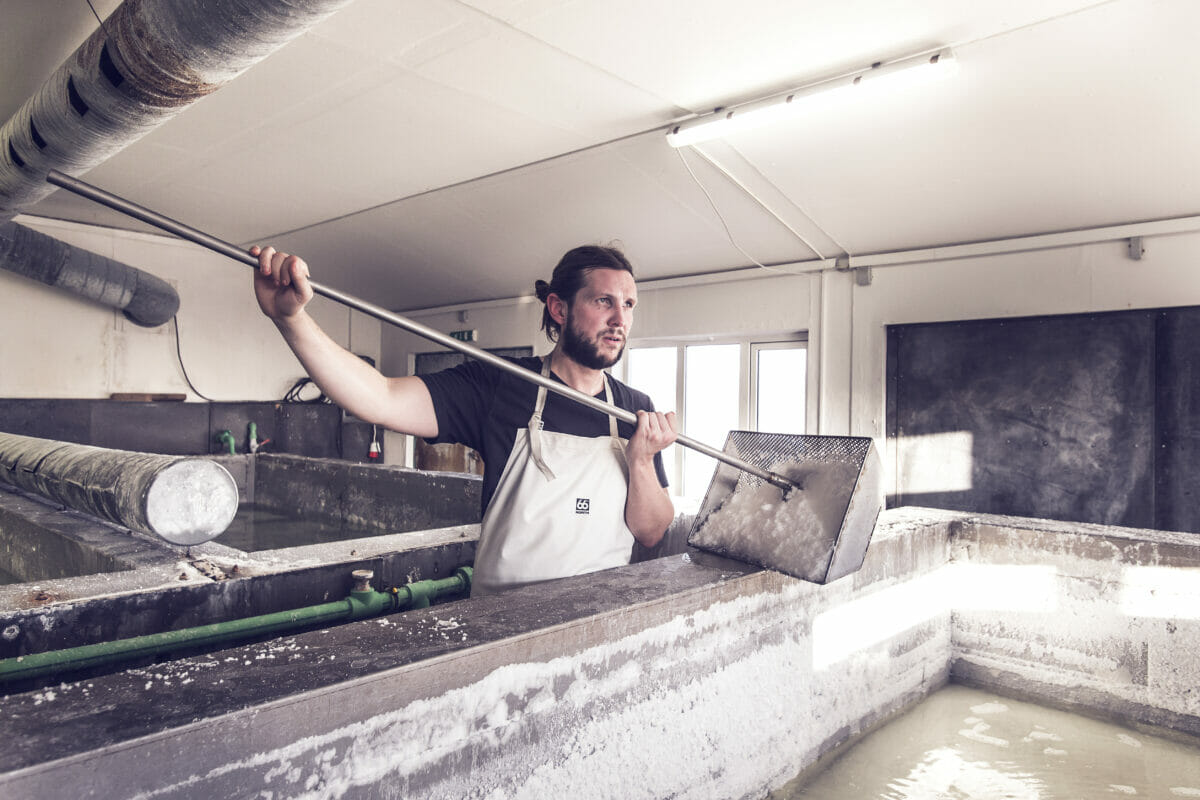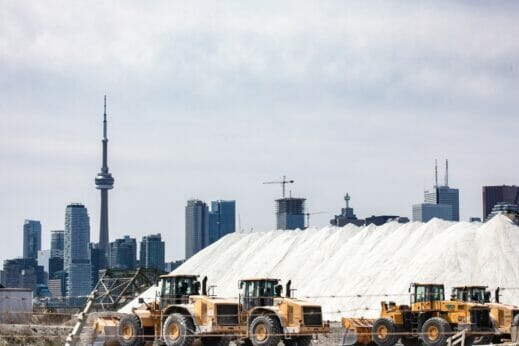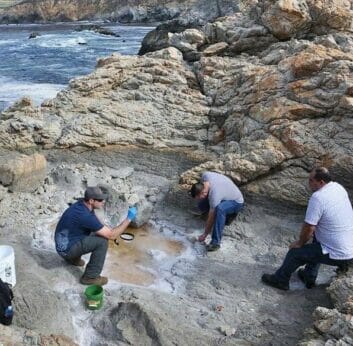Climate Disruptions Force Salt Farmers to Reimagine Their Businesses
To survive in the age of climate change, salt farmers from around the world will have to adjust their production methods and revenue streams.
Climate Disruptions Force Salt Farmers to Reimagine Their Businesses
To survive in the age of climate change, salt farmers from around the world will have to adjust their production methods and revenue streams.

Björn Steiner Jónsson’s Iceland-based Saltverk is powered by geothermal energy.courtesy Saltverk.
Salt is all around us—inside our oceans, beneath our feet, on our roadways, in our food and as part of the products we use every day. But with global temperatures climbing, weather events becoming more extreme and sea levels rising, salt producers in every corner of the globe face an uncertain future.
A $30-billion global industry, salt is a crucial food preservative, a keystone mineral in manufacturing and a common de-icing agent in chilly climes such as New York, Ohio and Illinois. Before industrial mining became widely available in the 20th century, “all salt was made from sea,” says Icelandic salt farmer Björn Steiner Jónsson. But today, most of the salt Americans use comes from underground deposits harvested in two energy-intensive ways: mining salt like a mineral and injecting water into salt deposits to create a brine that is then evaporated—a more expensive process, notes Jónsson.
For some farmers, lower humidity and higher temperatures have increased evaporation, creating a boon in the salt pans of northwest France, with the 2022 harvest reportedly nearly doubling the previous year’s yield. For others, warmer weather is decreasing production. Anna Lee, who farms salt with her husband Dave along Virginia’s Eastern Shore, says their company already halts production in the hottest months of the year when toxic algae blooms and increased microbial activity make harvesting unsafe.
Lurking in the background, too, is the knowledge that Barrier Islands Salt Co.’s shoreline solar evaporative pans, made from repurposed aquaculture infrastructure, could be rendered inoperable under rising seas. Today, “at high, high tides, our actual ground floor location can flood,” says Lee. Years from now, Barrier Islands Salt Co. might have to modify its operations significantly or relocate, “so that’s concerning,” she adds.

Even salt trapped in underground veins isn’t immune to rising temperatures. Rock salt makes up the bulk of the $2.5-billion US market, and Canada holds the title of greatest salt consumption per capita, mostly in the form of de-icer. Warmer global temperatures mean decreased demand for de-icing salt, forcing suppliers to adjust to new climate conditions.
Concurrently, erratic precipitation patterns are forcing farmers in Ghana and Indonesia to erect seasonally resistant infrastructure that allows for production even under the most severe weather conditions. In India, the world’s third-largest salt producer, longer rainy seasons have reduced brine harvests, financially crippling the Agariya people who have farmed the salt marshes for five generations. The switch from propane to solar-powered pumps has the potential to help stabilize this fluctuating market and secure the livelihoods of these subsistence farmers—all while reducing the emissions associated with production.
When atmospheric rivers swept through California in early 2023, salt farmer Carlo Overhulser spent days pumping thousands of gallons of fresh water out of his cliff-side cool saltwater pools. Not only did he lose time draining and refilling the pools with salt water, but the wetter weather also caused slower solar evaporation, substantially affecting Big Sur Salts’ annual harvest. “Normally, I can flip those ponds three times a year,” he says. “Now, I’m probably only going to be dealing with two.”

To stay in business, says Overhulser, farmers must be willing to adjust to fluctuating weather patterns and pivot accordingly. “In hotter, drier years, you have to produce more because you have to make up for the years that you’re not going to do that,” he says. He’s also bracing against the unpredictable nature of salt farming by expanding his offerings to include a host of salt-related activities: tours of the ponds, saltwater yoga classes and ocean-to-table dining experiences.
In addition to solar-evaporated sea salt, Overhulser produces flake salt inside hoop greenhouses using propane-run evaporative pans. Burning gas, he laughs, “is not the Big Sur way to do it.” Still, given a future of weather irregularity, the cost efficiency of propane and a market hungry for these types of specialty salts, fossil fuels remain the best option for many flake salt farmers. Lee reluctantly agrees. “You can obviously make a fine-grain salt from start to finish with solar, but if you want flake salt, you have to be able to really, really control the environment.”

Jónsson makes his salt in a controlled environment, but unlike other operations dependent on fossil fuels, Saltverk’s farm in the remote Westfjords uses “alternative ways of production where you’re able to do it in harmony with your ecosystem,” he says. The entire salt-making process is powered by emissions-free geothermal energy. Seawater from the North Arctic Ocean is pumped into open evaporative pans where it is pre-heated, boiled and dried, making Saltverk one of the world’s only fully sustainable flaky sea salt farms. The company is even investigating ways to produce salt with energy generated by geyser water previously used in industrial activity.
Whereas many salt farmers are strategizing ways to prevent or offset losses caused by the consequences of climate change, Saltverk’s carbon-free, weather-resilient production has prepared the company for expansion. Saltverk recently began exporting to the US, adding to the approximately 17,000 metric tons of salt imported annually. Jónsson plans to add more farms in Iceland and elsewhere in Europe.
The future of salt, according to Overhulser, will depend on the harvesters themselves. Salt farmers in the Anthropocene will have to transform their old ideas about both harvesting methods and revenue streams into new, more adaptable models as disruptions in climate patterns upend salt production and consumption around the world. Like Overhulser says, “It reminds you to not turn your back on the ocean.”
Follow us
This work is licensed under a Creative Commons Attribution-NoDerivatives 4.0 International License.
Want to republish a Modern Farmer story?
We are happy for Modern Farmer stories to be shared, and encourage you to republish our articles for your audience. When doing so, we ask that you follow these guidelines:
Please credit us and our writers
For the author byline, please use “Author Name, Modern Farmer.” At the top of our stories, if on the web, please include this text and link: “This story was originally published by Modern Farmer.”
Please make sure to include a link back to either our home page or the article URL.
At the bottom of the story, please include the following text:
“Modern Farmer is a nonprofit initiative dedicated to raising awareness and catalyzing action at the intersection of food, agriculture, and society. Read more at <link>Modern Farmer</link>.”
Use our widget
We’d like to be able to track our stories, so we ask that if you republish our content, you do so using our widget (located on the left hand side of the article). The HTML code has a built-in tracker that tells us the data and domain where the story was published, as well as view counts.
Check the image requirements
It’s your responsibility to confirm you're licensed to republish images in our articles. Some images, such as those from commercial providers, don't allow their images to be republished without permission or payment. Copyright terms are generally listed in the image caption and attribution. You are welcome to omit our images or substitute with your own. Charts and interactive graphics follow the same rules.
Don’t change too much. Or, ask us first.
Articles must be republished in their entirety. It’s okay to change references to time (“today” to “yesterday”) or location (“Iowa City, IA” to “here”). But please keep everything else the same.
If you feel strongly that a more material edit needs to be made, get in touch with us at [email protected]. We’re happy to discuss it with the original author, but we must have prior approval for changes before publication.
Special cases
Extracts. You may run the first few lines or paragraphs of the article and then say: “Read the full article at Modern Farmer” with a link back to the original article.
Quotes. You may quote authors provided you include a link back to the article URL.
Translations. These require writer approval. To inquire about translation of a Modern Farmer article, contact us at [email protected]
Signed consent / copyright release forms. These are not required, provided you are following these guidelines.
Print. Articles can be republished in print under these same rules, with the exception that you do not need to include the links.
Tag us
When sharing the story on social media, please tag us using the following: - Twitter (@ModFarm) - Facebook (@ModernFarmerMedia) - Instagram (@modfarm)
Use our content respectfully
Modern Farmer is a nonprofit and as such we share our content for free and in good faith in order to reach new audiences. Respectfully,
No selling ads against our stories. It’s okay to put our stories on pages with ads.
Don’t republish our material wholesale, or automatically; you need to select stories to be republished individually.
You have no rights to sell, license, syndicate, or otherwise represent yourself as the authorized owner of our material to any third parties. This means that you cannot actively publish or submit our work for syndication to third party platforms or apps like Apple News or Google News. We understand that publishers cannot fully control when certain third parties automatically summarize or crawl content from publishers’ own sites.
Keep in touch
We want to hear from you if you love Modern Farmer content, have a collaboration idea, or anything else to share. As a nonprofit outlet, we work in service of our community and are always open to comments, feedback, and ideas. Contact us at [email protected].by Gia Mora, Modern Farmer
May 22, 2023
Modern Farmer Weekly
Solutions Hub
Innovations, ideas and inspiration. Actionable solutions for a resilient food system.
ExploreExplore other topics
Share With Us
We want to hear from Modern Farmer readers who have thoughtful commentary, actionable solutions, or helpful ideas to share.
SubmitNecessary cookies are absolutely essential for the website to function properly. This category only includes cookies that ensures basic functionalities and security features of the website. These cookies do not store any personal information.
Any cookies that may not be particularly necessary for the website to function and are used specifically to collect user personal data via analytics, ads, other embedded contents are termed as non-necessary cookies.
This is moderately interesting, but I would prefer that Modern Farmer stick with farming [living organisms] and not expand into mining. Lithium brine, leaching of gold ore with fluids, and many other mineral extraction processes use water and are impacted by climate change and variation. There are plenty of media venues for that discussion. It ain’t farming.